Contents
- What does Chinese lemongrass look like?
- Description of the plant Lemongrass chinensis
- Schisandra chinensis in landscape design
- Plant varieties
- How to grow Chinese Schisandra from seeds
- How to plant Chinese lemongrass seedlings
- Chinese lemongrass care
- Features of planting and caring for Schisandra chinensis in Siberia
- Features of planting and caring for Chinese magnolia vine in the Urals
- Features of planting and caring for Chinese magnolia vine in the Moscow region
- Features of planting and caring for Chinese magnolia vine in the Leningrad Region
- When to Harvest Chinese Lemongrass
- Why Chinese magnolia vine does not bear fruit
- Schisandra chinensis diseases and how to treat them
- Conclusion
Chinese lemongrass is a vine with a beautiful appearance. The plant is increasingly spreading throughout Our Country. The fruits of the vine are used in folk medicine because they have medicinal properties. Growing and caring for Chinese magnolia vine can be carried out even in the harsh Siberian winters. It is important to know the nuances of Chinese liana agricultural technology.
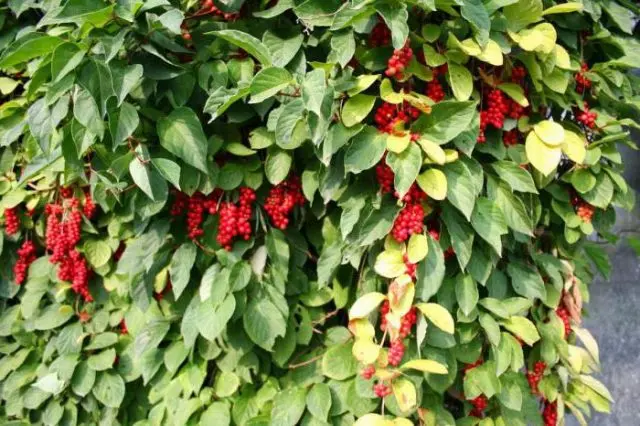
What does Chinese lemongrass look like?
Schisandra chinensis is a deciduous liana that can curl elegantly, create beautiful decorations on arbors, fences, poles around the site. The length of a climbing plant from China can reach 15 m. But they use it not only as an ornament, but also as a medicine. Decoctions, infusions, teas are made from lemongrass fruits.
Description of the plant Lemongrass chinensis
Directly, the trunk of lemongrass creeper reaches a thickness of 2,5 cm. Young shoots extend from the trunk in different directions. Serrated leaves are held on red, pink cuttings. They are dense and can change color dramatically throughout the season. At the very beginning in spring, young leaves have a light green tint, the inside is gray-gray. In summer, the color remains green; by autumn, lemongrass is dressed in yellow foliage.
During the flowering period, the entire vine is covered with white flowers. By autumn, instead of flowers, rounded fruits are formed. They are collected in brushes up to 10 cm long. The Chinese creeper has a characteristic citrus aroma. The smell is exuded by fruits, leaves with shoots. The characteristic aroma gives the garden a tropical atmosphere.
Schisandra chinensis in landscape design
Lemongrass Chinese in the photo, as in life, looks luxurious. In addition to medicinal properties, professionals and landscape design enthusiasts are aware of the decorative purpose of Chinese lemongrass.
More often the plant is used for its intended purpose – as a liana. Lemongrass creates weaving on walls, arches, in gazebos, along the body of buildings. The green arch will cheer up, decorate any site. A pleasant aroma will create a special atmosphere in the garden.
Often, with the help of a plant, terraces and gazebos are shaded. Weaving is used to create a hedge.
Plant varieties
A large number of varieties of lemongrass are known, since breeders have worked on its frost resistance, resistance to diseases and pests. As a result, gardeners and landscape designers have a wide choice. Each variety has advantages and some nuances, but in all the variety there are also the most popular varieties of creepers. For the most part, they have stood the test of time, are easy to care for and are very resistant to pests and diseases. An important factor is the yield parameter.
Lemongrass Chinese Firstborn
The first-born is a Chinese magnolia vine bred in Our Country. This is a monoecious vine, the height of which does not exceed 2 m. Up to 45 berries are collected in a brush. The fruits have a sweet and sour taste and a rounded shape. The leaves of this variety are ellipsoid, the teeth on the sides are rare with sharp ends. The Firstborn blooms with white flowers with a delicate pink tint.
This variety of Chinese lemongrass can be harvested in late August and early September. This is one of the most common varieties for Our Country. Domestic breeders bred the Firstborn, focusing on climatic conditions, humidity and soil quality. Chinese magnolia vine Pervenets is a frequent visitor to garden plots near Moscow. Handles winter well.
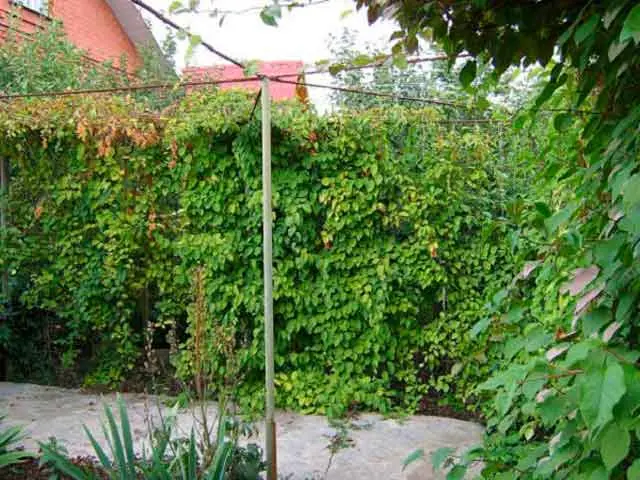
Lemongrass Chinese Schizandra
This is a classic Chinese lemongrass, which has been cultivated in the Ancient East. The length of the vine is up to 15 m. The root system of Schizandra is very branched, although it rarely goes beyond the crown. The trunk is strong, not brittle, the bark on an adult plant is dark brown, the buds are small or medium in size, dark brown in color. Most often, Chinese magnolia vine is a dioecious plant. This means that there are male and female specimens. This is important to know in order to harvest.
Lemongrass Chinese Delight
Woody liana. This variety has a later maturation. You can also harvest in October. Therefore, the plant is not always suitable for the northern latitudes of our country. Flowering at the Chinese magnolia vine Delight begins in May and lasts for several weeks. The flowers have a pleasant citrus scent.
Plant height – up to 15 m. Productivity from one bush – 4-5 kg of pleasant sweet and sour berries of a rounded shape. The weight of one lemongrass berry is approximately 5 g.
How to grow Chinese Schisandra from seeds
For Chinese magnolia vine, growing in the middle lane is not difficult. There are several methods for reproduction. You can buy seeds right away and just plant them according to a proven algorithm.
First of all, the seeds should be stratified. Stratification – storage of seeds in moist sand at a cool temperature. For the beginning of the month, the temperature should be + 18 ° С, at the second stage, the indicators are reduced to + 5 ° С, they also withstand a month, and in the third month the temperature is slightly raised to + 10 ° С.
Planting is carried out in June, immediately in open ground or in a greenhouse, depending on the climatic conditions of the region. After the appearance of the first three leaves, the seedlings dive. Watering the sown lemongrass is necessary only on hot days and, moreover, always in the morning.
Young lemongrass should be planted in a permanent place after the first wintering in the spring. It is better to cover young seedlings for the winter if they are not in a greenhouse.
How to plant Chinese lemongrass seedlings
Growing vines from seeds is troublesome and not always effective. Germination can be no higher than 60%. Therefore, the most popular simple planting method is seedlings. They are purchased in special nurseries or propagated by gardeners on their own.
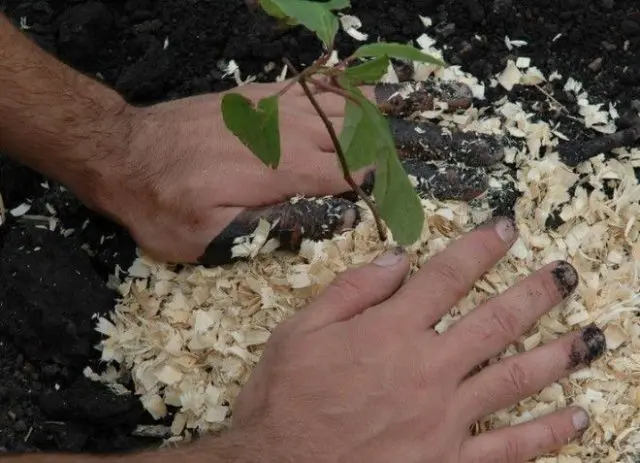
Site preparation
When choosing a site, you should pay attention to the illumination. Lemongrass loves sunlight, but feels great in the shade of the trees that it wraps around. It is important that the shadow should not be strong. Optimally – a semi-shady area, since direct sunlight, especially with rain watering, can cause a burn.
When planting near the wall of the house, the distance from the seedling to it should be about 1,5 m. If you plant a vine closer, it will destroy the roof of the building, water flows from the roof will have a bad effect on lemongrass and plant health.
The distance between seedlings should be about a meter. If it is less, then the shoots will quickly intertwine with each other, the bush will become too dense, and this will cause a decrease in the yield of the vine. The appearance of such shoots will be sloppy.
Humus, soddy soil, compost, and ash are used as a nutrient mixture for planting Chinese magnolia vine. All components are taken in equal quantities.
Seedlings preparation
Optimal seedlings for planting are 2-3-year-olds. At this age, planting material is low, strong enough. Able to survive the first winter and take root.
The result is a healthy plant. When choosing a seedling, you need to pay attention to the root system. Only healthy, developed roots can take root.
When buying, you should pay attention to the fact that the seedlings are with soil. The root system should be stored in a clod of earth in a cool place. Before planting, the roots should be lowered into a clay mash.
Rules of landing
In Siberia, in the Urals, Schisandra chinensis is planted in the spring, in the southern regions – in October. A hole is dug 60 cm wide, 40 cm deep. A drainage layer of 10-15 cm must be laid on the bottom. Pebbles or crushed stone are used by gardeners. The prepared nutrient mixture is poured over the drainage. Set up a seedling.
The roots should be carefully corrected, pour the nutrient mixture on top. Tamp the soil, then water. When the water is absorbed, it is recommended to make a layer of mulch from peat or humus from above around the seedling. The first time after planting, it is better to protect the plant, water it regularly.

Chinese lemongrass care
Caring for Chinese lemongrass is not difficult, since the liana is an unpretentious plant. But here there are some nuances for watering, feeding, preparing for winter. It is better to know and take into account such trifles so that the yield and appearance of the plant are not affected. Despite its exoticism, Chinese magnolia vine showed itself perfectly as a picky plant.
Watering mode
Chinese magnolia vine is considered more of a tropical crop, and therefore better tolerates moist soils. The vine should be watered regularly, because it needs moisture all the time, despite the horizontal arrangement of the roots. It is recommended to water lemongrass at the rate of 6 buckets for each vine.
The best option is rain watering. It is recommended to do this in the evening or at night so that the sun does not burn the watered leaves. If you water the vine with buckets, then it is recommended to do this with warm or settled water. Basal watering can be carried out in the daytime. This method of watering is most effective for young plants and seedlings. In order for the root zone not to dry out, after watering, peat or humus is laid around the vine.
How to feed Chinese lemongrass
Schisandra chinensis grows in the garden both for decoration and for a healing crop. But feeding an exotic plant is required in any case.
Liana should be fed several times a year. For each specific case, a different type of fertilizer is required.
When the liana is 3 years old, the first top dressing is carried out in the spring. To do this, saltpeter is poured into the trunk circle. Enough 30 g, then mulch.
After a few months in the summer, fertilizing with organic fertilizers is carried out. To do this, use chicken manure or cow dung. Mullein is bred in a ratio of 1:10, and chicken manure 1:20. Feeding is carried out several times during the summer with a break of 3 weeks. Organic fertilizers are applied under the root with the obligatory subsequent watering of the vine.
In the fall, after the shrub gives up its leaves, they are fertilized with superphosphate and wood ash.
A separate fertilizer regime exists for fruit-bearing vines to increase its yield:
- in the spring, nitroammophoska is applied at a rate of 4-40 g per square meter. m;
- after flowering – a bucket of chicken manure for each shrub;
- in autumn – superphosphate and sulfate stone.
Once every 3 years, compost should be planted 8 cm deep into the root zone.
How and when to prune Schisandra chinensis
The first pruning of lemongrass is carried out at the age of two years after planting. It is recommended to leave only 5-6 shoots, and cut the rest at ground level.
It is best if pruning is carried out in October, after the vine has shed its leaves. If the shrub is heavily neglected, then pruning is carried out in the month of July.
In the spring, root shoots are removed, and sanitary pruning is also carried out. With sanitary pruning, Chinese magnolia vine is deprived of all diseased, dry, frozen shoots.
Preparation for winter
Schisandra chinensis, when planting and caring, also needs to be prepared for the winter period. Young, immature plants are especially in need of preparation for cold weather. Such shoots should be covered, especially in cold regions. A layer of leaves and spruce branches are used as shelter.
Older plants do not need shelter, as they are able to endure frosty winters.
Features of planting and caring for Schisandra chinensis in Siberia
Siberia is characterized by cold long winters with deep snow cover. The main difference from cultivation in other regions is that even adult plants require shelter. Preparation for winter is carried out earlier than in other regions. Sawdust, leaves, peat are used for shelter, and snow is directly on top.
It is important to remove all shoots from the trellis. In the spring, the shoots that are frozen must be cut off. Planting seedlings in Siberia is recommended in the spring. The best time to plant is on an overcast April day, when the threat of a return of frost has passed. Mulching seedlings is a must. When planting by seed, it is recommended to harden the seedlings in advance.
Features of planting and caring for Chinese magnolia vine in the Urals
The frost resistance of Chinese magnolia vine is fixed at -40 °C. Therefore, an adult plant, like a young one, easily survives the Ural winters, but shelter is still required.
In the Urals, there are nuances when planting vines. Planting Schisandra chinensis in autumn is not recommended in the region. It is optimal to plant a seedling in the spring, when the threat of frost has passed. By autumn, it takes root and, when covered with spruce branches, calmly endures the winter.
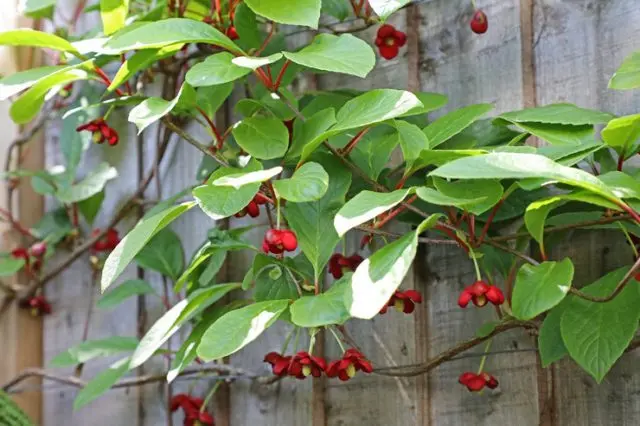
Features of planting and caring for Chinese magnolia vine in the Moscow region
In the Moscow region, the cultivation of Chinese magnolia vine is not as troublesome as in Siberia. Winters are mild here, it is required to cover the seedling from frost only in the first year of wintering. The rest of the winters the vine will endure without problems. In hot summers, the root soil should not be allowed to dry out and it is important to ensure regular watering of the plant.
Features of planting and caring for Chinese magnolia vine in the Leningrad Region
In the Leningrad region, an important climate factor is high humidity. This has a positive effect on Chinese magnolia vine, which loves moist soil and requires regular watering. But low temperatures require spring planting in this region. Shelter for the winter is needed only for two-year-old seedlings.
When to Harvest Chinese Lemongrass
In each region, lemongrass ripens at different times. This indicator also depends on the variety. Ripe lemongrass berries are bright red in color. The fruits are soft and almost transparent. Harvest completely with a brush along with the stalks.
Only vines older than 5 years bear fruit. This usually happens in the month of August. The fruits should be processed as soon as possible. For long-term storage, it is better to dry the fruits.
Why Chinese magnolia vine does not bear fruit
The lack of fruiting in vines can be due to a number of reasons:
- the plant has too many offspring, they do not allow the vine to bear fruit in the normal mode;
- too acidic soil, poorly fertilized when planting;
- lack of watering;
- lack of care and garters: the liana needs trellises, if it is not tied up and cut off, then for several years it may not bear fruit;
- the plant is planted in strong shade;
- the presence of pests or diseases.
Schisandra chinensis is a monoecious plant that has both male and female flowers. In this case, pollen falls from top to bottom. The higher the trellis is raised, the better the vine will bear fruit. The optimal height is 5 m. Too thick liana will also not be able to bear fruit normally, so gardeners recommend paying attention to the regular pruning of Chinese magnolia vine in the fall.
Schisandra chinensis diseases and how to treat them
Chinese liana is resistant to diseases. The plant, with proper care, does not get sick. Purchased seedlings can bring the disease to the site. There are Chinese disease creepers that spread with improper care. The most dangerous disease is Fusarium leaf wilt. If the disease has appeared, the plant cannot be treated. It is completely removed from the site, all shoots are burned.
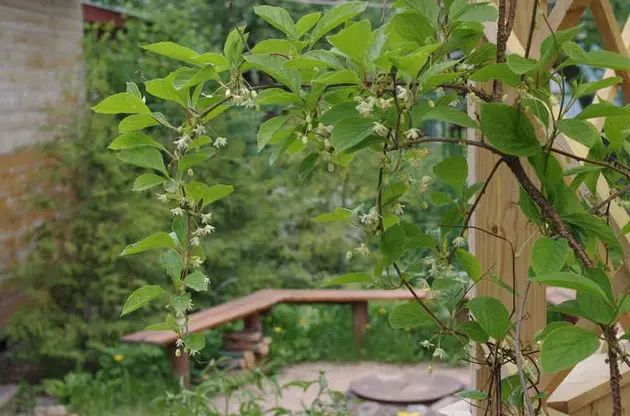
Chinese liana is sick:
- powdery mildew;
- black spotting.
Both diseases are treated by treatment with special preparations and the obligatory removal and burning of already infected leaves. The best option for processing vines is 1% Bordeaux liquid.
In the presence of powdery mildew, experts recommend spraying the vine with a solution of 0.5% soda ash and ground sulfur. It is advisable to repeat several times with a break of 2 weeks.
In order for lemongrass not to become infected with fusarium when planted using seeds, it is recommended to disinfect them with a 5% formalin solution.
Conclusion
Growing and caring for Chinese magnolia vine will pay off in full in any region of Our Country. Liana is unpretentious, frost-resistant enough. At the same time, it is used both in landscape design to decorate arbors and create arches, and for medicinal purposes. Folk recipes suggest using not only the red fruits of Schisandra chinensis, but also its leaves. It is important to water the vine in time, cut it regularly so that extra shoots and root suckers do not grow.









